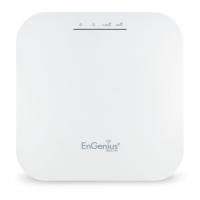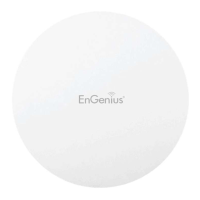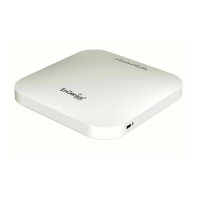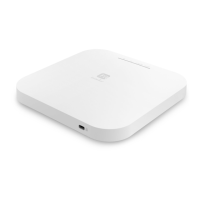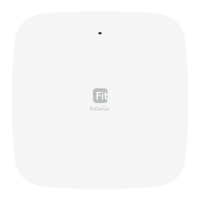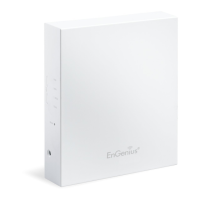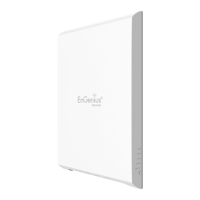Do you have a question about the EnGenius EWS385AP and is the answer not in the manual?
Details the main capabilities and purpose of the EnGenius EWS385AP access point.
Lists minimum computer requirements and items included in the EWS385AP package.
Provides comprehensive technical details including radio, interface, dimensions, and environment specs.
Identifies and describes the physical ports, buttons, and indicators on the access point.
Guides users on configuring computer network settings for accessing the access point.
Provides instructions for physically mounting the EnGenius EWS385AP access point on ceilings or walls.
Explains default IP address, username, password, and how to access the web configuration.
Describes how the AP functions as a central connection point for wireless clients.
Explains how to use the EWS385AP as a central hub for mesh network connectivity.
Describes how to save, apply, or revert configuration changes made to the access point.
Shows how to view current operating mode and general system information of the AP.
Covers IP addressing, subnet masks, gateway, DNS, and Spanning Tree Protocol configuration.
Configures device name, band steering, and region settings for wireless operation.
Details operation modes, wireless modes, channel bandwidth, and transmit power for both bands.
Guides on setting up security modes like WEP, WPA-PSK, and WPA-Enterprise for wireless networks.
Explains traffic shaping, download/upload limits, and per-user bandwidth controls.
Enables seamless roaming for mobile devices between access points using WPA Enterprise.
Allows creation of a separate network for guest access, including IP settings and SSID hiding.
Sets the RSSI level to determine when a client should handover to a different access point.
Configures access control based on MAC addresses to allow or deny network access.
Assigns a VLAN tag to packets for network management and segregation.
Configures SNMP settings for network monitoring and management.
Sets the internal clock of the AP, including time zone and daylight saving options.
Schedules automatic reboots for the access point to maintain stability.
Creates schedules to enable or disable Wi-Fi access for specific times and days.
Provides tools to test connection quality and trace network routes to a target.
Allows changing the administrator username and password for accessing the AP.
Guides on how to upgrade the access point's firmware to the latest version.
Explains how to back up current configurations or restore factory/user default settings.
Details how to view system logs and set up remote logging for the access point.
Instructions on how to properly log out of the access point's management interface.
Provides steps to reboot the device or restore it to factory or user default settings.
FCC compliance information regarding interference and radiation exposure limits.
Industry Canada compliance statements for interference and radar usage.
CE conformity statements and essential requirements for European Union markets.
Details the main capabilities and purpose of the EnGenius EWS385AP access point.
Lists minimum computer requirements and items included in the EWS385AP package.
Provides comprehensive technical details including radio, interface, dimensions, and environment specs.
Identifies and describes the physical ports, buttons, and indicators on the access point.
Guides users on configuring computer network settings for accessing the access point.
Provides instructions for physically mounting the EnGenius EWS385AP access point on ceilings or walls.
Explains default IP address, username, password, and how to access the web configuration.
Describes how the AP functions as a central connection point for wireless clients.
Explains how to use the EWS385AP as a central hub for mesh network connectivity.
Describes how to save, apply, or revert configuration changes made to the access point.
Shows how to view current operating mode and general system information of the AP.
Covers IP addressing, subnet masks, gateway, DNS, and Spanning Tree Protocol configuration.
Configures device name, band steering, and region settings for wireless operation.
Details operation modes, wireless modes, channel bandwidth, and transmit power for both bands.
Guides on setting up security modes like WEP, WPA-PSK, and WPA-Enterprise for wireless networks.
Explains traffic shaping, download/upload limits, and per-user bandwidth controls.
Enables seamless roaming for mobile devices between access points using WPA Enterprise.
Allows creation of a separate network for guest access, including IP settings and SSID hiding.
Sets the RSSI level to determine when a client should handover to a different access point.
Configures access control based on MAC addresses to allow or deny network access.
Assigns a VLAN tag to packets for network management and segregation.
Configures SNMP settings for network monitoring and management.
Sets the internal clock of the AP, including time zone and daylight saving options.
Schedules automatic reboots for the access point to maintain stability.
Creates schedules to enable or disable Wi-Fi access for specific times and days.
Provides tools to test connection quality and trace network routes to a target.
Allows changing the administrator username and password for accessing the AP.
Guides on how to upgrade the access point's firmware to the latest version.
Explains how to back up current configurations or restore factory/user default settings.
Details how to view system logs and set up remote logging for the access point.
Instructions on how to properly log out of the access point's management interface.
Provides steps to reboot the device or restore it to factory or user default settings.
FCC compliance information regarding interference and radiation exposure limits.
Industry Canada compliance statements for interference and radar usage.
CE conformity statements and essential requirements for European Union markets.
| 2.4 GHz | Yes |
|---|---|
| MIMO type | Multi User MIMO |
| Modulation | 16-QAM, 64-QAM, 256-QAM, BPSK, CCK, DBPSK, DQPSK, QPSK |
| Frequency band | 2.412 - 2.484, 5.18-5.24 & 5.26-5.32 & 5.5-5.7 & 5.745-5.825, 5.15-5.25, 5.25-5.35 GHz |
| Fit AP mode features | Mesh networking |
| Networking standards | IEEE 802.11a, IEEE 802.11ac, IEEE 802.11b, IEEE 802.11g, IEEE 802.11i, IEEE 802.11k, IEEE 802.11n, IEEE 802.11r, IEEE 802.1D, IEEE 802.1Q, IEEE 802.3, IEEE 802.3ab, IEEE 802.3af, IEEE 802.3u |
| Virtual LAN features | Tagged VLAN |
| Spread spectrum method | DSSS, OFDM |
| Ethernet LAN data rates | 10, 100, 1000 Mbit/s |
| Maximum data transfer rate | 1734 Mbit/s |
| Maximum data transfer rate (5 GHz) | 867 Mbit/s |
| Maximum data transfer rate (2.4 GHz) | 400 Mbit/s |
| USB 2.0 ports quantity | - |
| Ethernet LAN (RJ-45) ports | 2 |
| AC input voltage | 100 - 240 V |
| AC input frequency | 50 - 60 Hz |
| Power consumption (max) | 12 W |
| Placement | Ceiling, Wall |
| Certification | FCC, IC, CE |
| Product color | White |
| Cable lock slot type | Kensington |
| Antenna type | Internal |
| Antenna features | Integrated antenna |
| Antennas quantity | 6 |
| Antenna direction type | Omni-directional |
| Antenna gain level (max) | 5 dBi |
| Security algorithms | 802.1x RADIUS, MD5, PEAP, SSL/TLS, TTLS, WPA2-EAP, WPA2-PSK |
| Number of SSID supported | 8 |
| Service Set Identifier (SSID) features | Multiple SSIDs |
| Storage temperature (T-T) | -40 - 80 °C |
| Operating temperature (T-T) | 0 - 40 °C |
| Cables included | LAN (RJ-45) |
| Harmonized System (HS) code | 85176990 |
| Width | 200 mm |
|---|---|
| Height | 540 mm |
| Weight | 40.64 g |
